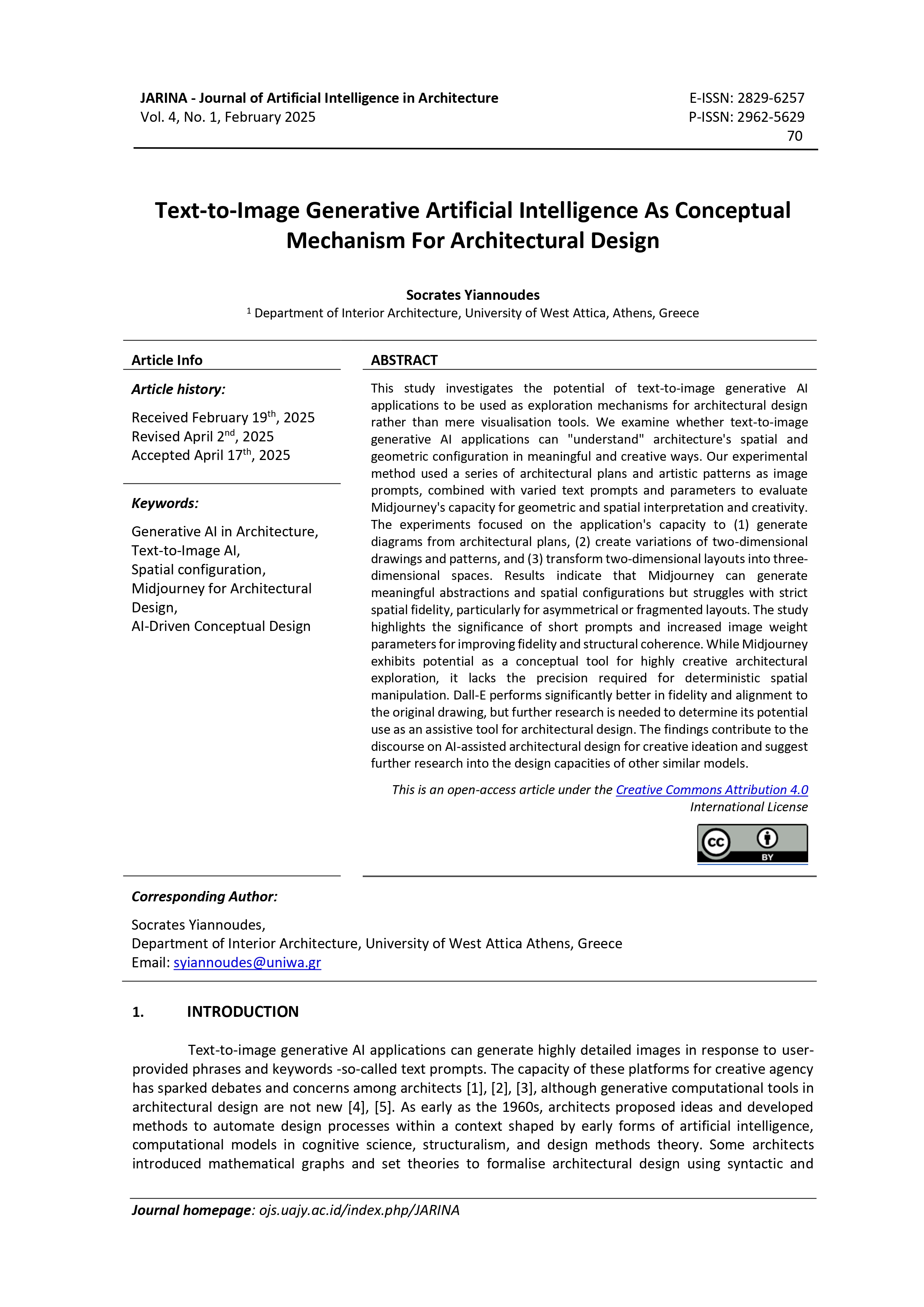Text-to-Image Generative Αrtificial Intelligence As Conceptual Mechanism For Architectural Design
DOI:
https://doi.org/10.24002/jarina.v4i2.10992Keywords:
Generative AI in Architecture, Text-to-Image AI, Spatial configuration, Midjourney for Architectural Design, AI-Driven Conceptual DesignAbstract
This study investigates the potential of text-to-image generative AI applications to be used as exploration mechanisms for architectural design rather than mere visualisation tools. We examine whether text-to-image generative AI applications can "understand" architecture's spatial and geometric configuration in meaningful and creative ways. Our experimental method used a series of architectural plans and artistic patterns as image prompts, combined with varied text prompts and parameters to evaluate Midjourney's capacity for geometric and spatial interpretation and creativity. The experiments focused on the application's capacity to (1) generate diagrams from architectural plans, (2) create variations of two-dimensional drawings and patterns, and (3) transform two-dimensional layouts into three-dimensional spaces. Results indicate that Midjourney can generate meaningful abstractions and spatial configurations but struggles with strict spatial fidelity, particularly for asymmetrical or fragmented layouts. The study highlights the significance of short prompts and increased image weight parameters for improving fidelity and structural coherence. While Midjourney exhibits potential as a conceptual tool for highly creative architectural exploration, it lacks the precision required for deterministic spatial manipulation. Dall-E performs significantly better in fidelity and alignment to the original drawing, but further research is needed to determine its potential use as an assistive tool for architectural design. The findings contribute to the discourse on AI-assisted architectural design for creative ideation and suggest further research into the design capacities of other similar models.
References
[1] N. Leach, Architecture in the Age of Artificial Intelligence: An Introduction to AI for Architects. London: Bloomsbury Visual Arts, 2022.
[2] M. Del Campo and N. Leach, ‘Can Machines Hallucinate Architecture? AI as Design Method’, Architectural Design, vol. 92, no. 3, pp. 6–13, May 2022, doi: 10.1002/ad.2807.
[3] L. Manovich, ‘AI and Myths of Creativity’, Architectural Design, vol. 92, no. 3, pp. 60–65, May 2022, doi: 10.1002/ad.2814.
[4] P. Steadman, ‘Generative Design Methods and the Exploration of Worlds of Formal Possibility’, Architectural Design, vol. 84, no. 5, pp. 24–31, Sep. 2014, doi: 10.1002/ad.1804.
[5] Y. J. Grobman, A. Yezioro, and I. G. Capeluto, ‘Computer-Based Form Generation in Architectural Design — A Critical Review’, International Journal of Architectural Computing, vol. 7, no. 4, pp. 535–553, Dec. 2009, doi: 10.1260/1478-0771.7.4.535.
[6] L. March and P. Steadman, The Geometry of Environment: An Introduction to Spatial Organization in Design. London: Routledge, 1971.
[7] G. Stiny and J. Gips, ‘Shape Grammars and the Generative Specification of Painting and Sculpture’, in Information Processing 71, Amsterdam: NorthHolland, 1972, pp. 1460–1465.
[8] J. Frazer, An evolutionary architecture. London: Architectural Association, 1995.
[9] M. Makki, M. Showkatbakhsh, A. Tabony, and M. Weinstock, ‘Evolutionary algorithms for generating urban morphology: Variations and multiple objectives’, International Journal of Architectural Computing, vol. 17, no. 1, pp. 5–35, Mar. 2019, doi: 10.1177/1478077118777236.
[10] P. Coates, Programming.architecture. London/New York: Routledge, 2010.
[11] G. Lynn, Animate form. New York: Princeton Architectural Press, 1999.
[12] M. L. Castro Pena, A. Carballal, N. Rodríguez-Fernández, I. Santos, and J. Romero, ‘Artificial intelligence applied to conceptual design. A review of its use in architecture’, Automation in Construction, vol. 124, p. 103550, Apr. 2021, doi: 10.1016/j.autcon.2021.103550.
[13] J. S. Gero, ‘Architectural Optimization-A Review’, Engineering Optimization, vol. 1, no. 3, pp. 189–199, Jan. 1975, doi: 10.1080/03052157508960586.
[14] ‘Where architects and AI design together - The generative copilot for better buildings’, Finch. Accessed: Dec. 18, 2025. [Online]. Available: https://www.finch3d.com
[15] T. Galanos, A. Liapis, and G. N. Yannakakis, ‘Architext: Language-Driven Generative Architecture Design’, 2023, arXiv. doi: 10.48550/ARXIV.2303.07519.
[16] B. Ennemoser and I. Mayrhofer-Hufnagl, ‘Design across multi-scale datasets by developing a novel approach to 3DGANs’, International Journal of Architectural Computing, vol. 21, no. 2, pp. 358–373, Jun. 2023, doi: 10.1177/14780771231168231.
[17] P. Pouliou, A.-S. Horvath, and G. Palamas, ‘Speculative hybrids: Investigating the generation of conceptual architectural forms through the use of 3D generative adversarial networks’, International Journal of Architectural Computing, vol. 21, no. 2, pp. 315–336, Jun. 2023, doi: 10.1177/14780771231168229.
[18] V. Paananen, J. Oppenlaender, and A. Visuri, ‘Using text-to-image generation for architectural design ideation’, International Journal of Architectural Computing, vol. 22, no. 3, pp. 458–474, Sep. 2024, doi: 10.1177/14780771231222783.
[19] B. Dreith, ‘How AI software will change architecture and design’, Dezeen. Accessed: Nov. 05, 2024. [Online]. Available: https://www.dezeen.com/2022/11/16/ai-design-architecture-product
[20] W. dPrix, K. Schmidbaur, D. Bolojan, and E. Baseta, ‘The Legacy Sketch Machine: From Artificial to Architectural Intelligence’, Architectural Design, vol. 92, no. 3, pp. 14–21, May 2022, doi: 10.1002/ad.2808.
[21] Enjellina, E. V. P. Beyan, and Anastasya Gisela Cinintya Rossy, ‘Review of AI Image Generator: Influences, Challenges, and Future Prospects for Architectural Field’, JARINA, vol. 2, no. 1, pp. 53–65, Feb. 2023, doi: 10.24002/jarina.v2i1.6662.
[22] Y. Cao, A. Abdul Aziz, and W. N. R. Mohd Arshard, ‘Stable diffusion in architectural design: Closing doors or opening new horizons?’, International Journal of Architectural Computing, p. 14780771241270257, Aug. 2024, doi: 10.1177/14780771241270257.
[23] M. Sadek, ‘Artificial Intelligence as a pedagogical tool for architectural education: What does the empirical evidence tell us?’, MSA Engineering Journal, vol. 2, no. 2, pp. 133–148, Mar. 2023, doi: 10.21608/msaeng.2023.291867.
[24] T. Chandrasekera, Z. Hosseini, and U. Perera, ‘Can artificial intelligence support creativity in early design processes?’, International Journal of Architectural Computing, p. 14780771241254637, May 2024, doi: 10.1177/14780771241254637.
[25] C. Fang et al., ‘Generative AI-enhanced human-AI collaborative conceptual design: A systematic literature review’, Design Studies, vol. 97, p. 101300, Mar. 2025, doi: 10.1016/j.destud.2025.101300.
[26] E. Vissers-Similon, T. Dounas, and J. De Walsche, ‘Classification of artificial intelligence techniques for early architectural design stages’, International Journal of Architectural Computing, p. 14780771241260857, Jul. 2024, doi: 10.1177/14780771241260857.
[27] D. Schon, The Reflective Practitioner. New York: Harper Collins, 1983.
[28] D. Kim, ‘Latent morphologies: Encoding architectural features and decoding their structure through artificial intelligence’, International Journal of Architectural Computing, vol. 22, no. 3, pp. 353–372, Sep. 2024, doi: 10.1177/14780771231209458.
[29] A. Loos, ‘Regarding Economy’, in Raumplan versus Plan Libre, New York: Rizzoli, 1988, pp. 137-142.
[30] B. Tschumi, ‘Architecture of Limits’, in Architecture and Disjunction, Cambridge, MA: MIT Press, 1996.
[31] A. Forty, Words and Buildings. London: Thames & Hudson, 2004.
[32] L. Ekenstam, ‘Tutorial: Dynamic Prompting’, Inside my Head. Accessed: Nov. 05, 2024. [Online]. Available: https://insidemyhead.ai/p/tutorial-dynamic-prompting
[33] G. Raj, ‘An Ultimate Guide to Get Architectural Design Images Using AI Art Generators’, Decentralizedcreator. Accessed: Nov. 12, 2024. [Online]. Available: https://decentralizedcreator.com/an-ultimate-guide-to-get-architectural-design-images-using-ai-art-generators
[34] G. Raj, ‘4 Free Prompt Generators for DALL.E 2’, Decentralizedcreator. Accessed: Nov. 12, 2024. [Online]. Available: https://decentralizedcreator.com/free-prompt-generators-for-dall-e-2
[35] Y. Zhou and H.-J. Park, ‘An AI-augmented multimodal application for sketching out conceptual design’, International Journal of Architectural Computing, vol. 21, no. 4, pp. 565–580, Dec. 2023, doi: 10.1177/14780771221147605.
[36] G. Baudoux, ‘The benefits and challenges of artificial intelligence image generators for architectural ideation: Study of an alternative human-machine co-creation exchange based on sketch recognition’, International Journal of Architectural Computing, vol. 22, no. 2, pp. 201–215, Jun. 2024, doi: 10.1177/14780771241253438.
[37] A. Kudless, ‘Hierarchies of bias in artificial intelligence architecture: Collective, computational, and cognitive’, International Journal of Architectural Computing, vol. 21, no. 2, pp. 256–279, Jun. 2023, doi: 10.1177/14780771231170272.
[38] I. As, S. Pal, and P. Basu, ‘Artificial intelligence in architecture: Generating conceptual design via deep learning’, International Journal of Architectural Computing, vol. 16, no. 4, pp. 306–327, Dec. 2018, doi: 10.1177/1478077118800982.
[39] A. H.-C. Hwang, ‘Too Late to be Creative? AI-Empowered Tools in Creative Processes’, in CHI Conference on Human Factors in Computing Systems Extended Abstracts, New Orleans LA USA: ACM, Apr. 2022, pp. 1–9. doi: 10.1145/3491101.3503549.

Downloads
Published
How to Cite
Issue
Section
License
Copyright (c) 2025 Socrates Yiannoudes

This work is licensed under a Creative Commons Attribution 4.0 International License.
Authors who publish with this journal agree to the following terms:
1.Authors retain copyright and grant the journal right of first publication with the work simultaneously licensed under a Creative Commons that allows others to share the work with an acknowledgement of the work's authorship and initial publication in this journal.
2.Authors are able to enter into separate, additional contractual arrangements for the non-exclusive distribution of the journal's published version of the work (e.g., post it to an institutional repository or publish it in a book), with an acknowledgement of its initial publication in this journal.
3.Authors are permitted and encouraged to post their work online (e.g., in institutional repositories or on their website) prior to and during the submission process, as it can lead to productive exchanges, as well as earlier and greater citation of published work (See The Effect of Open Access).
















